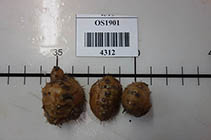Amicula vestita (Broderip & Sowerby I, 1829)
Warning: DOMDocument::load(): SSL operation failed with code 1. OpenSSL Error messages: error:140770FC:SSL routines:SSL23_GET_SERVER_HELLO:unknown protocol in C:\Apache24\htdocs\includes\SpeciesSummary.lib.php on line 1236
Warning: DOMDocument::load(): Failed to enable crypto in C:\Apache24\htdocs\includes\SpeciesSummary.lib.php on line 1236
Warning: DOMDocument::load(https://sealifebase.nrm.se/webservice/AquaMaps/getAMap.php?genus=Amicula&species=vestita): failed to open stream: operation failed in C:\Apache24\htdocs\includes\SpeciesSummary.lib.php on line 1236
Warning: DOMDocument::load(): I/O warning : failed to load external entity "https://sealifebase.nrm.se/webservice/AquaMaps/getAMap.php?genus=Amicula&species=vestita" in C:\Apache24\htdocs\includes\SpeciesSummary.lib.php on line 1236
Classification / Names Common names | Synonyms | CoL | ITIS | WoRMS
| Chitonida | Mopaliidae
Environment: milieu / climate zone / depth range / distribution range Ecología
; rango de profundidad 0 - 100 m (Ref. 289). Temperate
Distribución Países | Áreas FAO | Ecosistemas | Ocurrencias, apariciones | Introducciones
Northeast Pacific, Atlantic ocean and Arctic Ocean: Alaska and USA. Temperate to polar.
Length at first maturity / Tamaño / Peso / Age
Maturity: Lm ? range ? - ? cm Max length : 6.0 cm TL macho / no sexado; (Ref. 289)
Depth: Intertidal to 100 m. Habitat: On rocks (Ref. 289). Body: Oval; with the valves nearly covered by a brown skin continued upward from the girdle, but their outlines are plainly visible through this integument. Small exposed portion of each median valve: Broadly heart-shaped and situated at the posterior margin of each valve; it is sculptured with strong concentric grooves and a more or less distinct granulation. Girdle: Thin, smooth with sparsely scattered small bunches of hairs (Ref. 297). Known to occur on bathyal, infralittoral and circalittoral of the Gulf and estuary (Ref. 87872).
Life cycle and mating behavior Madurez | Reproducción | Puesta | Huevos | Fecundidad | Larva
Sexes are separate but they are indistinguishable externally. Fertilization is external and usually the eggs are shed into the water.
Main reference
Referencias | Coordinador | Colaboradores
Burghardt, G. and L. Burghardt. 2006. (Ref. 296)
IUCN Red List Status (Ref. 130435)
CITES status (Ref. 108899)
Not Evaluated
CMS (Ref. 116361)
Not Evaluated
Threat to humans
Human uses
| FishSource |
Herramientas
Más información
Países
Áreas FAO
Ecosistemas
Ocurrencias, apariciones
Introducciones
Stocks
Ecología
Dieta
componentes alimenticios
Áreas FAO
Ecosistemas
Ocurrencias, apariciones
Introducciones
Stocks
Ecología
Dieta
componentes alimenticios
Age/Size
Crecimiento
Length-weight
Length-length
Morfología
Larva
Abundancia
Crecimiento
Length-weight
Length-length
Morfología
Larva
Abundancia
Fuentes de Internet
BHL | BOLD Systems | CISTI | DiscoverLife | FAO(Publication : search) | Fishipedia | GenBank (genome, nucleotide) | GloBI | Gomexsi | Google Books | Google Scholar | Google | PubMed | Árbol de la vida | Wikipedia (Go, búsqueda) | Expediente Zoológico
Estimates based on models
Preferred temperature
(Ref. 115969): 0.2 - 9.1, mean 2.2 (based on 1202 cells).
Price category
(Ref. 80766):
Unknown.



